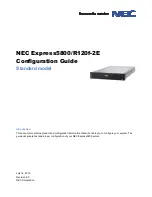
Document Number: 002-00948 Rev. *C
S29CD032J
S29CD016J
S29CL032J
S29CL016J
10. Electronic Marking
Electronic marking has been programmed into the device, prior to shipment from Cypress, to ensure traceability of individual
products. The electronic marking is stored and locked within a one-time programmable region. Detailed information on Electronic
Marking will be provided in a data sheet supplement.
11. Power Conservation Modes
11.1
Standby Mode
When the system is not reading or writing to the device, it can place the device in standby mode. In this mode, current consumption
is greatly reduced, and outputs are placed in a high impedance state, independent of OE# input. The device enters CMOS standby
mode when the CE# and RESET# inputs are both held at V
CC
± 10%. The device requires standard access time (t
CE
) for read
access before it is ready to read data. If the device is deselected during erasure or programming, the device draws active current
until the operation is completed. I
CC5
represents the standby current specification.
Caution
Entering standby mode via the RESET# pin also resets the device to read mode and floats the data I/O pins. Furthermore, entering
I
CC7
during a program or erase operation leaves erroneous data in the address locations being operated on at the time of the
RESET# pulse. These locations require updating after the device resumes standard operations. See
for further discussion of the RESET# pin and its functions.
11.2
Automatic Sleep Mode
The automatic sleep mode minimizes Flash device energy consumption. The automatic sleep mode is independent of the CE#, WE#
and OE# control signals. While in sleep mode, output data is latched and always available to the system.
While in asynchronous mode, the device automatically enables this mode when addresses remain stable for t
ACC
+ 60 ns. Standard
address access timings provide new data when addresses are changed. While in synchronous mode, the device automatically
enables this mode when either the first active CLK level is greater than t
ACC
or the CLK runs slower than 5 MHz. A new burst
operation is required to provide new data. I
CC8
in
DC Characteristic, CMOS Compatible on page 49
represents the automatic sleep
mode current specification.
11.3
Hardware RESET# Input Operation
The RESET# input provides a hardware method of resetting the device to reading array data. When RESET# is driven low, the
device immediately terminates any operation in progress, tristates all outputs, resets the configuration register, and ignores all read/
write commands for the duration of the RESET# pulse. The device also resets the internal state machine to reading array data. Any
operation that was interrupted should be reinitiated once the device is ready to accept another command sequence, in order to
ensure data integrity.
When RESET# is held at V
SS
±0.2 V, the device draws CMOS standby current (I
CC4
). If RESET# is held at V
IL
but not within V
SS
±0.2 V, the standby current is greater.
RESET# may be tied to the system reset circuitry, thus a system reset would also reset the Flash memory, enabling the system to
read the boot-up firmware from the Flash memory.
If RESET# is asserted during a program or erase operation, the RY/BY# pin remains low until the reset operation is internally
complete. This action requires between 1 µs and 7 µs for either Chip Erase or Sector Erase. The RY/BY# pin can be used to
determine whether the reset operation is complete. Otherwise, allow for the maximum reset time of 11 µs.
If RESET# is asserted when a program or erase operation is not executing (RY/BY# = 1), the reset operation completes within 500
ns. The Simultaneous Read/Write feature of this device allows the user to read a bank after 500 ns if the bank is in the read/reset
mode at the time RESET# is asserted. If one of the banks is in the middle of either a program or erase operation when RESET# is
asserted, the user must wait 11 µs before accessing that bank.
Asserting RESET# active during V
CC
and V
IO
power up is required to guarantee proper device initialization until V
CC
and V
IO
have
reached steady state voltages.
11.4
Output Disable (OE#)
When the OE# input is at V
IH
, output from the device is disabled. The outputs are placed in the high impedance state.
















































